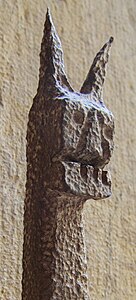Ferro (architecture)
| Ferro da facciata | |
|---|---|
 Ferro in Piazza del Duomo, Florence | |
| Material | Wrought iron |
A ferro (plural ferri) or ferro da facciata is an item of functional wrought-iron work on the façade of an Italian building. Ferri are a common feature of Medieval and Renaissance architecture in Lazio, Tuscany and Umbria. They are of three main types: ferri da cavallo have a ring for tethering horses, and are set at about 1.5 metres from the ground; holders for standards and torches are placed higher on the façade and on the corners of the building; arpioni have a cup-shaped hook or hooks to support cloth for shade or to be dried, and are set near balconies.[1]
In Florence, ferri da cavallo and arpioni were often made to resemble the head of a lion, the symbolic marzocco of the Republic of Florence.[2] Later, cats, dragons, horses and fantastic animals were also represented.[2][3]
-
Bargello, Florence
-
Ferro from two ages, Palazzo degli Altoviti, Florence
-
Palazzo Morozzi Dilaghi, Florence
-
Ferro in Arezzo
-
Niccolò Grosso - "Il Caparra" Palazzo Strozzi c.1500
-
"Ferro" in Pisa, Italy
-
Standard-holder, Rome
-
Standard-holder, Borgo San Lorenzo
-
Arpione, Palazzo degli Altoviti, Florence
-
Torch-holder, Via de' Giraldi, Florence
References
- ^ [s.n.] (2001). Bisol: tra arte e tecnologia (in Italian). Il Ferro Battuto 18 (unpaginated). Accessed October 2015.
- ^ a b [staff] ( 26 September 2014). Gatti, cavalli e draghi sui muri di Firenze (in Italian). Nove da Firenze. Accessed October 2015.
- ^ John Superti (20 June 2013). Invisible horses: Rediscovering Florence's ferri. The Florentine (186/2014). Accessed October 2015.
Further reading
- Assunta Maria Adorisio (1996). Per Uso e Per Decoro: L’arte del ferro a Firenze e in Toscana dal eta gotica al XX secolo. Florence: Maria Christina de Montemayor.
- Giulio Ferrari. ([1920?]) Il ferro nell'arte Italiana. Centosettanta tavole riproduzioni in parte inedite di 368 soggetti, del medio evo, del rinascimento, del periodo barocco e neo-classico raccolte e ordinate con testo esplicativo. Kraus Reprint, 1973.
- James Lindow (2007). The Renaissance Palace in Florence: magnificence and splendor in fifteenth-century Italy. Aldershot, England; Burlington, VT: Ashgate.
- Claudio Paolini. Repertorio delle architettura civili di Firenze. [Database] Palazzo Spinelli – Ente Cassa di Risparmio di Firenze.
- Augusto Pedrini (1929). Il ferro battuto, sbalzato e cesellato, nell-arte italiana, dal secolo undicesimo al secolo diciottesimo. Milan: Ulrico Hoepli. (Published in English: Decorative ironwork of Italy. Atglen PA: Schiffer Publishers, 2010.)
- Urbano Quinto (1998). Gli antichi segreti del fabbro. Galleria Urbano Quinto.
- Herbert Railton (1900). Pen drawings of Florence. Cleveland, Ohio: J.H. Jansen.
- John Superti (2014). I Cavalli di Firenze = The Horses of Florence. Florence: Polistampa.
- John Superti (2013) Florence's Ironworks - Ferri https://www.youtube.com/watch?v=zKQ5s9Lk1Bo











